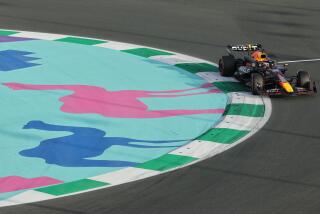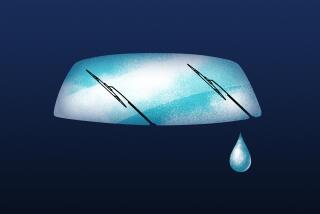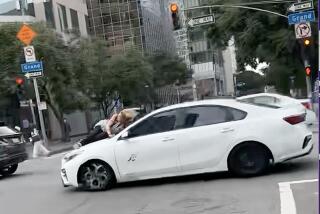The rubber meets the war
- Share via
BAGHDAD — Bilal Hussein gazed lovingly at his 1991 Mustang GT convertible. Sure, it already has a skull in a jester’s hat stenciled on the hood, but if the sky were the limit, well. . . . He’d add monster tires, a new stereo “and a set of mufflers that shoot out flames.”
And his automotive holy grail? Hydraulics to make his car bounce like the ones he sees on TV.
“If only we had the materials here,” Hussein, a 26-year-old ambulance driver, said wistfully.
Seif Eddin Abdel Nasser has more modest dreams for his 1993 red Ford Probe with yellow racing stripes and “Fright Night” stenciled on the rear window.
“I just want to be able to drive it all over Baghdad,” he said.
For now, the 22-year-old, who works as a security guard for the Baghdad bureau of a Western television news station, feels safe driving only in the fairly quiet, upscale districts of Karada and Jadriya.
“I never go near Palestine Street, Yarmouk, Beirut Square” or other dodgy districts, he said.
These are conflicted times for Baghdad’s tightknit community of car-heads.
The fall of Saddam Hussein has enabled them to create their dream rides like never before. Hussein’s notorious son Uday and his cronies personally controlled all car imports into Iraq. Uday was also a car freak known for on-the-spot confiscations of any vehicle that caught his fancy.
The end of the Hussein era opened Iraq’s borders to an unrestrained flow of new and used cars, along with exotic parts and Western car magazines. The MTV show “Pimp My Ride” is now a popular feature on Arabic satellite television; Bilal Hussein, the Mustang driver who dreams of flaming mufflers, is a big fan.
But the dictator’s ouster also unleashed a new era of Baghdad lawlessness that makes owning a head-turning ride a dangerous hobby. In addition to the threat from roving gangs of opportunistic carjackers, there are armed fundamentalists, both Sunni and Shiite, who might view an overly showy car as sinfully extravagant.
“We have the Mahdi Army on one side, Al Qaeda on the other side, thieves everywhere, and we’re caught in the middle,” said Hussein, who also sticks to safer streets.
The dangers of the Baghdad streets don’t seem to discourage Adnan Ghulan, 27, who, along with his 28-year-old brother, Hisham, runs an auto repair shop that’s one of the anchors of the city’s car culture.
Hussein and Abdel Nasser are regular visitors. Abdel Nasser often brings in pages from one of his favorite car magazines with suggested designs or modifications for his Probe.
The Ghulan brothers, ethnic Kurds who lived in Jordan for several years and returned to Iraq after Saddam Hussein’s fall, have owned a succession of hot rods that they describe in loving detail.
“I want to have a car that makes people turn their heads as I drive by,” said Adnan Ghulan, who favors sleeveless shirts that show off a collection of tattoos.
Their current pride and joy -- a tricked-out white 1987 BMW M3 with front and rear spoilers, broad blue and red stripes, and a red eagle on the door -- certainly turns heads.
They bought it from a man who put the car in storage for years after being chased by Uday Hussein’s thugs one night.
Inside, the pimping is even more over the top -- red and yellow leather everywhere, dragons on the floorboards and a set of stereo speakers that take up most of the back seat.
“We’re not finished yet,” said Hisham Ghulan, who wouldn’t expand on his planned modifications and was reluctant to let his ride be photographed before he was done.
Abu Moustafa, owner of a venerable central Baghdad auto accessories store, has watched the new trends with bemusement. In business since the 1980s, he used to deal exclusively in practical needs such as seat cushions, brake pedals and mirrors.
After Hussein’s ouster, demand increased for stenciled designs on car doors -- mostly religious slogans or Iraqi flags. But in the last year, he said, the requests have become more flamboyant. Customers want stylized lettering, strange nonsensical slogans in English (for instance, the Ghulans have a huge red and yellow banner across the top of their windshield that says “DRAGEN BOL”) and the occasional wild animal.
“One guy requested a large dragon,” said Abu Moustafa, who has a sign on the wall pleading, “Please . . . PLEASE no talking about religion or politics.”
Besides eye-catching details, Iraq’s resurgent gear heads want speed. Adnan Ghulan boasts of getting up to 150 mph on the highways, but he frowns on urban street-racing as irresponsible. He cheerfully acknowledges that his taste in autos makes him a target for carjacking, or worse.
But he’s supremely confident in his ability to outrun and outmaneuver any threats.
He speaks from experience. Once, while driving from Amman, Jordan, at night, he was chased by a carload of gunmen outside the city of Ramadi, a former insurgent stronghold. He cut his lights and floored it all the way to Baghdad, never touching his brakes for fear the lights would give him away.
About 18 months ago, he and a friend were stuck in Baghdad traffic when a car pulled alongside and four armed men emerged and ordered them out of the car. Against Ghulan’s advice, his friend got out. But when the driver of the armed group’s car left his vehicle, Ghulan hit the gas, jumped the median and took off at top speed against incoming traffic.
His friend was left behind and received a beating.
But in the Wild West of modern-day Iraq, even carjackers need to watch their step. Hisham Ghulan and Abdel Nasser recently eluded would-be thieves with the same trick of jumping the median and escaping against traffic.
“We went home and got weapons and came back to look for them,” Hisham Ghulan said, “but they were gone.”
--
Times staff writer Saif Rasheed contributed to this report.
More to Read
Sign up for Essential California
The most important California stories and recommendations in your inbox every morning.
You may occasionally receive promotional content from the Los Angeles Times.










